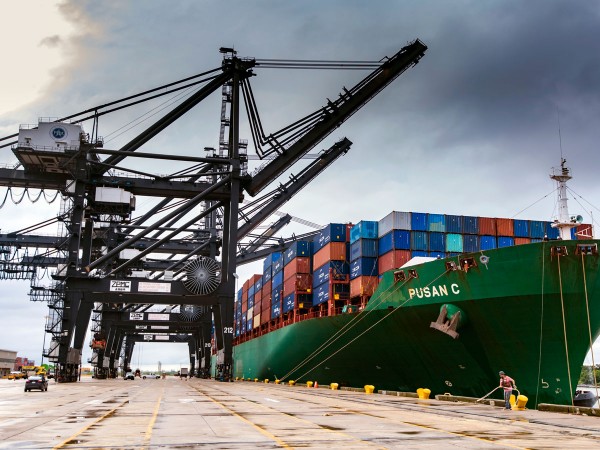Fitch Ratings has affirmed approximately $594 million of outstanding Port of Houston Authority, TX (Port Houston, the authority) unlimited tax bonds at 'AA', and affirmed Port Houston's Issuer Default Rating (IDR) at 'AA'. The Rating Outlook is Stable.
KEY RATING DRIVERS
The ratings reflect a strong general obligation unlimited tax pledge, which is levied on a sizable and growing base that exhibits minimal taxpayer concentration for the general obligation (GO) bonds. However, despite a very sizable and healthy tax base, the GO rating is constrained by the Port's IDR of 'AA', which considers the revenue generating capacity of port operations. The IDR considers Port Houston's position as a major maritime gateway for both Texas and the U.S., ranking first in the country in petroleum, steel and project cargo, and sixth in 20-foot equivalent unit (TEU) throughput. The rating also reflects the port's long-term positive growth trends and historically stable cargo revenues through economic cycles. Port Houston currently has no revenue-backed debt, with its capital improvements thus far being funded via ad-valorem taxes and excess cash flows from operations. The forward capital program is expected to total slightly under $1 billion and may require future borrowing. The rating reflects the port's expected ability to service anticipated future debt under various sensitivity scenarios at strong coverage levels and low leverage levels that are commensurate with an 'AA' rating.

Strong Port Franchise - Revenue Risk (Volume): Stronger
Port Houston is one of the nation's largest maritime ports with numerous terminals and facilities along the Houston Ship Channel. The overall port complex ranks second in the U.S. in total tonnage and includes eight public terminals, which handle breakbulk, general and containerized cargo, plus over 150 privately owned docks and facilities. The port benefits from proximity to Houston, TX, the fourth largest city in the U.S. and an area that has shown resilience through economic downturns.
Diverse Revenues - Revenue Risk (Price): Stronger
Operating revenues are 93% derived from vessel and cargo services, with the remaining 7% coming from leases and other sources. In the breakbulk portion of the business, the port operates as a landlord with two long-term contracts for the use of dock facilities. With regards to the container side, the port runs the Barbours Cut and Bayport terminals as operator.
Sizable Capital Program - Infrastructure Development/Renewal: Stronger
While existing facilities are in good repair, the port's sizable but manageable capital improvement plan (CIP) calls for approximately $902 million in funding for projects through 2023, and approximately $1 billion every five years thereafter. The current capital budget focuses on expansion and ongoing maintenance needs, including retrofitting for Barbours Cut; continued expansion of the Bayport terminal; and various turning basin, breakbulk and general cargo facility improvements. The port anticipates that operating cash flows may be sufficient to fund the CIP over the next 5 to 10 years, though, should additional funding be needed, the port continues to explore various financing alternatives, including additional GO bonds, revenue obligations and equipment financing, to ensure that they are prepared to fund such additional capital improvement projects.
No Revenue Debt Outstanding - Debt Structure: Stronger
The port has $593.8 million in rated unlimited tax bonds outstanding, all fixed rate, with final maturity in 2039. Debt service is fully funded from voter-approved ad valorem taxes in Harris County, with no support from port revenues. The assessed valuation of the port's tax base is sizable at $437.7 billion in 2018 and has exhibited strong growth, as evidenced by a 5.9% compound growth rate over the past decade. The previous flexible-rate revolving notes program expired in September 2018, though was replaced with a new five-year, $100 million revolving note program. To date, no draws have been made on the facility, and no revenue debt is outstanding or planned.
Financial Profile
Financial metrics appear very strong. Leverage is initially negative when considering the capacity of the existing notes program, on which no draws have been made. Under a full-draw scenario in 2019 and continuation of the program through 2023, coverage remains at 34x or better, and leverage remains below 0.5x. In the more conservative rating case, which assumes a recessionary downturn in revenues, coupled with full implementation of the CIP, amortization of a $100 million note program, and $200 million in additional revenue-backed borrowing in 2020, coverage remains above 3.7x. By 2023, leverage still remains low at under 1.0x in the rating case.
PEER GROUP
While there are no direct comparables to Port Houston on a metrics basis given Houston's lack of revenue debt outstanding, the closest comparable ports include Port Miami (rated 'A'), which serves the east coast/gulf and competes with Houston to some degree. Miami has considerably higher leverage than Houston; however, Houston has a larger, cash-funded, forward capital program than Miami. Both ports benefit from alternate debt financing sources for their capital plans (via Houston's GO debt and Miami-Dade County's County and Sunshine State debt). Houston also compares favorably to the Ports of Los Angeles and Long Beach (both rated AA), with lower throughput volumes but greater diversification and balance of trade in cargos.
RATING SENSITIVITIES
Future Developments That May, Individually or Collectively, Lead to Negative Rating Action:
--Future borrowing for the CIP that increases revenue-backed leverage materially above 4x without corresponding increases to net revenues.
Future Developments That May, Individually or Collectively, Lead to Positive Rating Action:
--Longer term, successful execution of the capital plan with higher than expected net revenue generation or a larger portion of unlimited tax-backed debt than anticipated, reducing leveraging on the revenue-backed lien
CREDIT UPDATE
Performance Update
The Port of Houston's taxable district includes the entirety of Harris County, which is the center of the Houston MSA. Harris County is the largest county in Texas and the third largest in the nation, encompassing all but a small portion of the city of Houston, with a population totaling over 4.6 million. The county features a large, diverse economy that remains exposed to the energy sector. The county's population grew at a substantial rate of nearly 14% from 2010-2017. Fitch expects county assessed value (AV), currently at nearly $437.6 billion, to continue to grow, albeit at a more moderate rate going forward following posting double-digit growth in recent years. Property taxes are levied only to pay debt service on voter-authorized unlimited tax bonds.
From the operational side, container traffic as measured in TEUs rose by nearly 10% in fiscal 2018, following similar growth of nearly 13% in 2017. Port management has stated that local petrochemical industry partners have made substantial investments in the last few years to expand their manufacturing facilities, resulting in higher resin exports via containers. It would appear reasonable for the growth in such exports to moderate somewhat over the next five years. Steel tonnage increased in 2018 by 18.1% following a 56.0% increase in 2017 and a 51.0% decrease in 2016. Previous declines were due to pricing slump and less demand for steel in the oil industry. YTD steel tonnage stands at almost 1.6 million tons, an increase of 32% over the same period of 2018. Auto tonnage was up 8.3% in 2018, following a 14.8% decrease in 2017, and continues to increase in 2019 (23% higher compared with first four months of 2018). Bulk cargo was 2% lower in 2018 due to a 35.7% decrease in grain volumes and 1.8% decrease in other bulk volumes.
Port Houston's operating revenues increased by approximately 11%, following a 15% increase in 2017. Revenues at the Turning Basin terminals were up 5% versus 2017, mainly attributable to a rise in rent/lease revenues within those terminals, while other operating revenues decreased $1.3 million primarily from a decline in dredge material placement fees. With expenses (excluding depreciation) increasing by 7.5%, the increase in operating revenues lead to higher net cash flow at $177 million versus $147 million in fiscal 2017. Operating margins remain strong and given the lack of revenue bond debt service, the net cash flow provides sound funding for pay-go capital.
Fitch Cases
The port provided Fitch with its detailed CIP budget and liquidity analysis through 2023, and Fitch used this forecast as a basis for its cash flow models. Fitch views the five-year plan as conservative, as it does not factor in any inflation of expenses or increases in revenues due to increases in tariffs.
The Fitch Base Case assumes modest 4.3% five-year average growth in container revenues from 2019 through 2023, and assumes no growth in lease revenues from 2021 onwards and no growth in bulk revenues from 2019 onwards. Overall revenues grow at 4.0% through 2023 (versus 4.8% in the port's five-year plan) while expenses are assumed to be growing at a 3.5% CAGR. Fitch has assumed the current notes program was drawn in full in 2018 and remains outstanding through the forecast period, paying interest only at 5%. Fitch also assumes roughly $30 million in short-term CIP borrowing under this scenario, though the port expects to be able to pay their current CIP without additional borrowings. Debt service coverage remains high (27x-30x as the notes are interest-only). Leverage is low, never rising above 0.7x.
The Fitch Rating Case assumes a downturn in 2019, resulting in 8% decline across all revenue categories, followed by 5% recovery in 2020, then a return to 3% growth thereafter for cargo-related revenues except bulk, which is held flat to reflect potential tariff impacts. Overall revenues grow 0.9% through 2023. Total expenses decrease by 4% in the recession year, then grow at a steady 4% per year through 2023, for a 2.4% CAGR. Fitch has assumed the notes program is refinanced with $100 million of 10-year long-term fixed-rate debt at 5%. An additional $200 million debt issuance is also assumed to be issued in 2020 to further support the CIP. Despite this borrowing under a recessionary scenario, coverage remains strong for the rating level (3.7x or better). Leverage as measured by net debt to CFADS is low, remaining at or below 1x even when considering the additional borrowing.
Fitch views the port's credit profile as extremely robust, with strong coverage levels and low leverage levels that are commensurate with an 'AA' rating. In addition to resilient credit metrics, the port benefits from flexibility provided by its liquidity position, its stable historical performance, and its ability to potentially fund future CIP needs using both the GO and revenue liens.
Asset Description
The port owns a diverse group of facilities designed to accommodate a variety of cargo, including general cargo, containers, grain, coal, pet coke, dry and liquid bulk and project and heavy lift cargo. In operation since 1914 as a deep draft port, the port is ranked first in the nation for foreign waterborne tonnage, and second in terms of total tonnage. The Houston Ship Channel extends 52 miles inland and links the City of Houston with the Gulf of Mexico. The channel serves some of the largest petrochemical terminals and refineries in the world. Generally the port acts as a landlord port for breakbulk cargos, while acting as an operator for the container terminal yards, with a few exceptions.
VARIATION FROM PUBLISHED CRITERIA
Fitch's analysis supporting the 'AA' IDR on the port includes a variation from the 'Rating Criteria for Infrastructure and Project Finance'. Enhanced analysis under the variation relates to the evaluation of the strength of the tax revenue and legal framework to support operations. This evaluation is supported by Fitch's 'U.S. Tax-Supported Rating Criteria' dated April 3, 2018.









